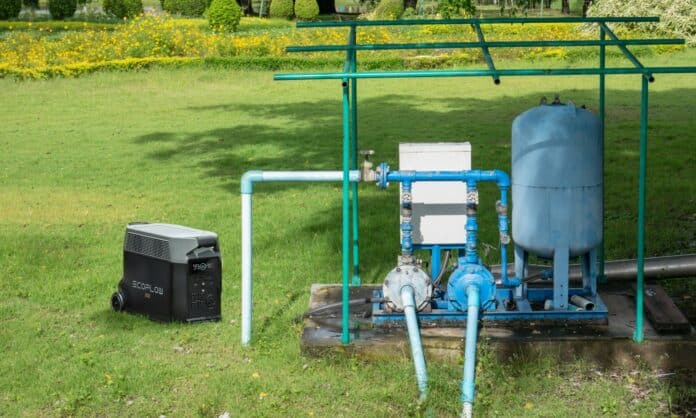Table of Contents
In rural areas, you still need access to essentials like water and power. Well pumps ensure anyone outside a city or even a suburb can still access water for drinking, showers, sinks, and toilets. However, a well pump requires energy to work, and understanding the wattage requirements of your well pump can help determine your options for power sources.
Many people pair their pump with an eco-friendly solar generator. The first step to finding the right solar generator for your well pump is calculating its power consumption. Below, we’ll help you understand your pump’s wattage and grasp the formula used to find your specific number.
Understanding Well Pump Wattage
Well pumps comprise several components, including the well casing, well cap, well screen, pitless adapter (sometimes), and the pump itself. The wattage of your rural property or tiny home’s well pump depends on a few things, from its size and horsepower to the type of pump.
Common types of pumps include submersible, jet, turbine, and cylinder pumps. Submersible pumps are the most popular, offering flexibility at various depths. Jet pumps are available for shallow or deep wells and work similarly to submersible pumps. Turbine pumps are centrifugal pumps typically reserved for wells with high water flow. Finally, cylinder pumps are typically for windmills or other off-grid installations.
When it comes to well pumps, wattage isn’t just a number; it’s a mark of self-sustainability. For every homeowner, whether using grid power or alternative sources, the wattage of any appliance offers a direct insight into the energy load and cost.
The wattage of a pump is a crucial consideration for people on the move, off the grid, and those looking to reduce their carbon footprint. But, as it shifts between pump types and usage, it’s not a one-size-fits-all figure.
To understand your starting and running wattage, you need to know that this measurement is directly correlated to its pump motor size or horsepower rating. One horsepower is about 746 watts, and well pumps can come in a range of motor sizes, anywhere from .33 hp (750-800 running watts) to 10 hp (15,000-16,000 running watts).
How Many Watts Does A Well Pump Consume?
The answer to this is more complex. Well pumps come in various sizes, and their energy consumption fluctuates accordingly. However, to give you an idea, a typical household with a small pump can use anywhere from 400-500 watts, while a larger pump can use upwards of 5k watts.
The average pump consumption is about 700-800 running watts, and most wells run for about 8 hours, bringing the total daily consumption to around 5.6 to 6.4 kilowatts.
Calculating Well Pump Power Consumption
To understand a well pump’s power consumption, knowing a few terms, including the pump’s volts, amps, and efficiency, is helpful.
Volts (V): voltage is the speed of the electric current flowing through the circuit.
Amps (A): amperage measures the electric current flowing through the circuit at a given time.
Watts (W): wattage is the device’s energy consumption.
Since we know that a one-hp pump is roughly 750 watts, we can use the following formula to convert its watts to amps. Let’s say that it operates on the household standard of 240 volts.
750 W = 240V x Amps
So, 750/240 = 3.12 Amps
To illustrate differently, if you know the amps and volts but don’t know the wattage (240 volts and draws 10 amps), the calculation would be:
Power (W) = 240V x 10A = 2400 watts
Keep in mind this is the power when the pump is running. When it cycles on or off, there might also be a momentary spike in consumption.
Advantages of Using Solar Energy for Well Pumps
Once you know the power consumption needs of your pump, you can find a power source to match it, such as an EcoFlow DELTA Series Solar Generator like the EcoFlow DELTA 2, which provides up to 1800W (2.7k W surge) of output to power up most well pumps.
Why should you consider using solar energy for your well pump? The appeal lies in its independence from traditional sources. When we apply solar energy to well pumps, the benefits are multifold:
No Pollution
Solar energy produces no air or water pollution, making it an eco-friendly option compared to petrol-guzzling generators or traditional grid electricity, which often relies on fossil fuels.
No Noise
Compared to the loud noise levels of petrol or diesel generators, solar-powered well systems run silently, contributing to a more peaceful living environment when you’re already located in a rural spot.
Cost-Effective
While the initial investment in solar might seem steep, the installation cost is offset by the savings in energy bills over time. Maintaining a solar-powered well pump is less expensive than a traditional one.
Off-Grid Capable
A solar-powered well pump allows homeowners to optimise their pump for their needs, regardless of the grid’s availability, increasing flexibility and resilience.
Environmentally Sustainable
For the environmentally conscious, solar energy systems don’t contribute to climate change, making them an excellent option for more sustainable living.
Frequently Asked Questions
You need more than just the voltage to know the wattage of a well pump. To complete the formula, you’d also need to know the amperage. Generally speaking, depending on horsepower and pressure requirements, a 220-volt well pump can typically range from 400W to 2,500W.
Final Thoughts
The wattage of your well pump is a figure worth knowing, whether you’re a homeowner tapping into self-sufficient living or someone intrigued by the allure of solar power. For those looking to switch to a quiet, eco-friendly, and off-grid capable solution, EcoFlow’s portable power stations offer a reliable and efficient means to power your well pump and other home essentials, no matter where you are.


